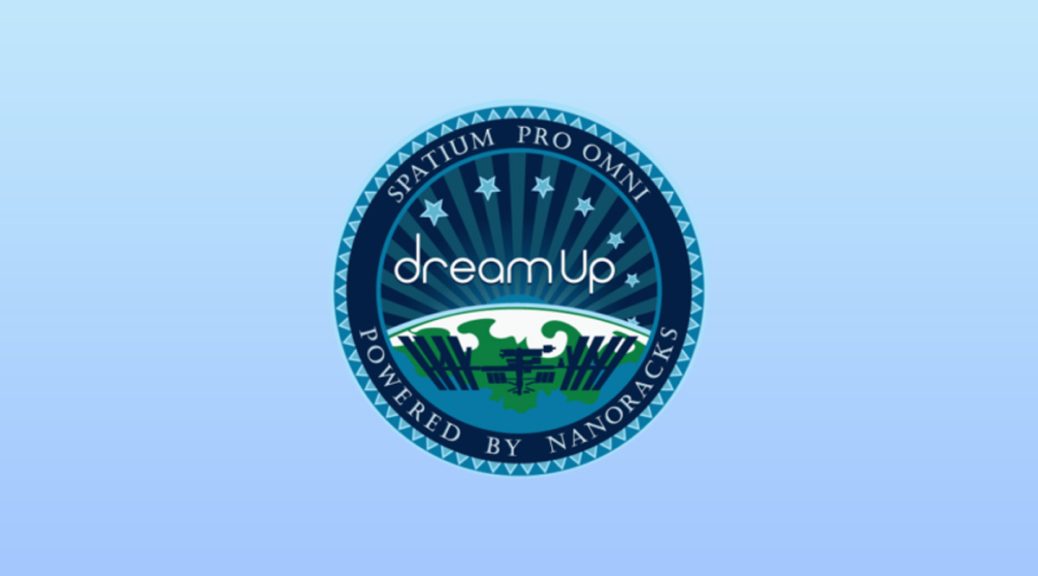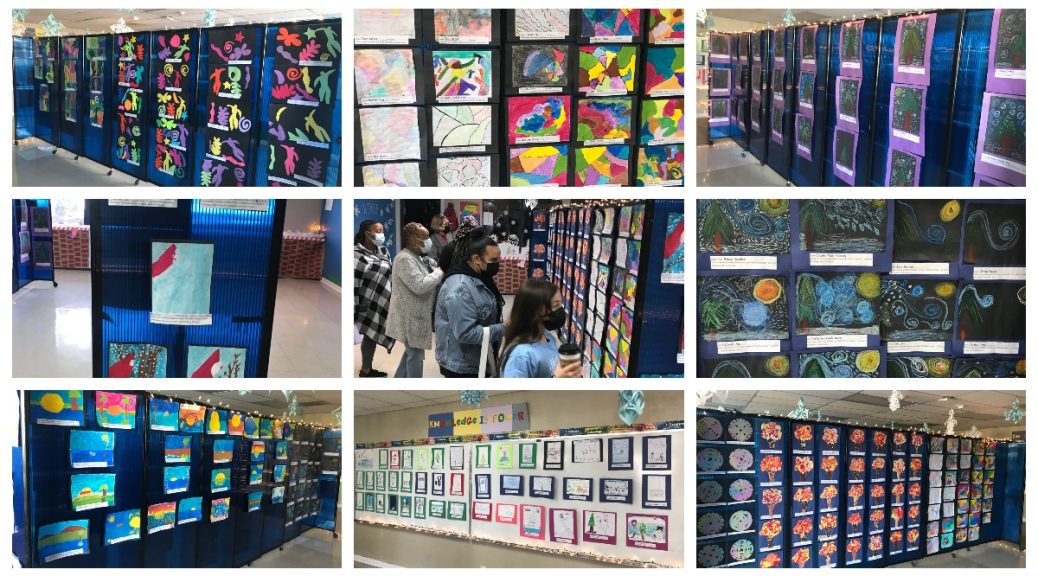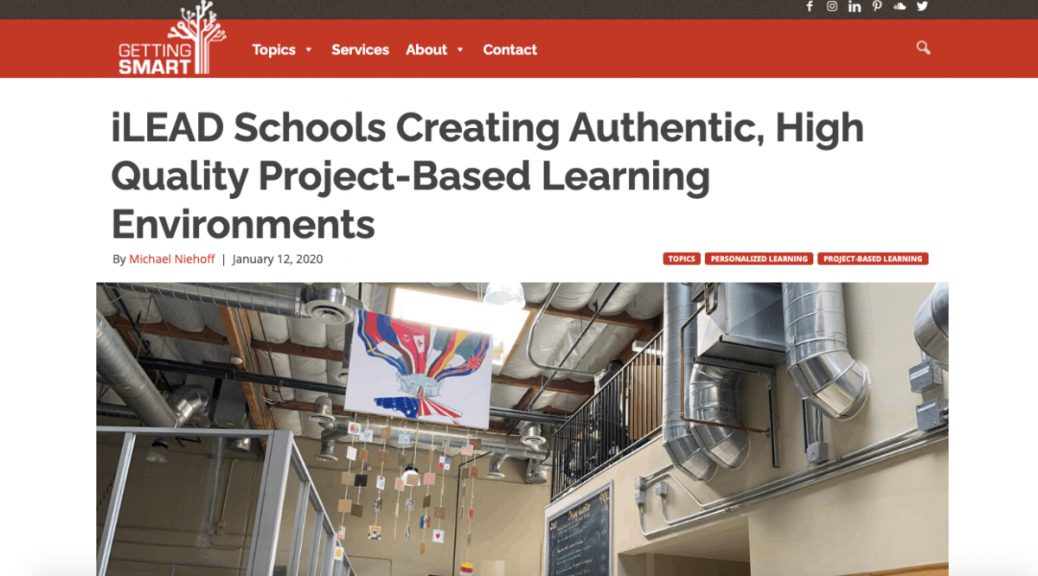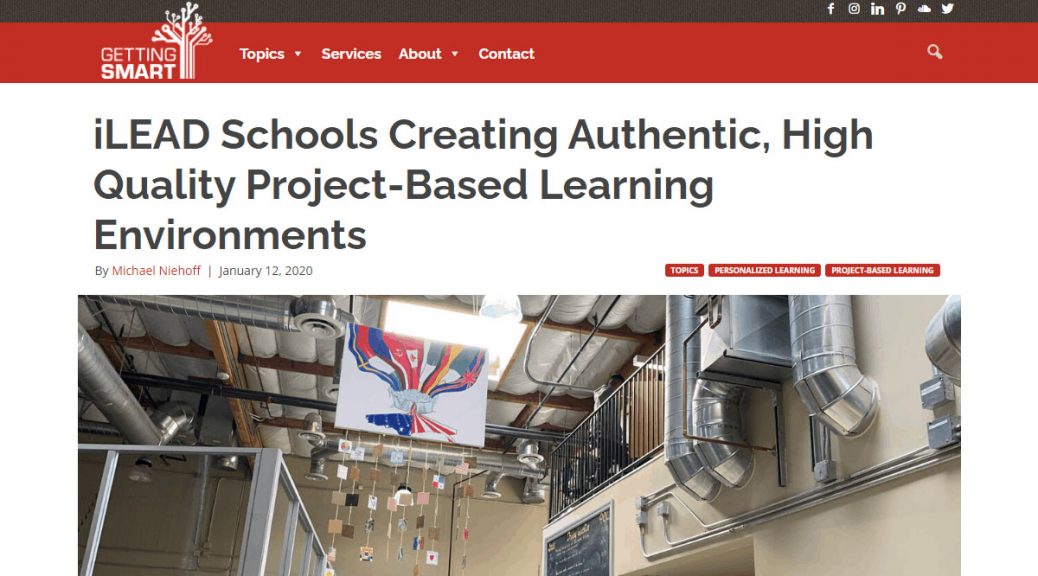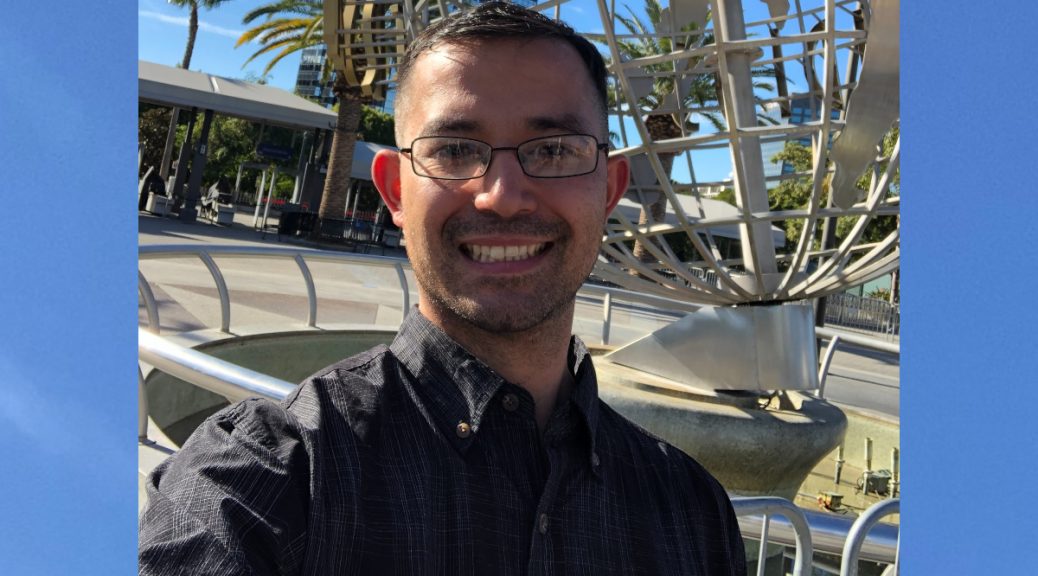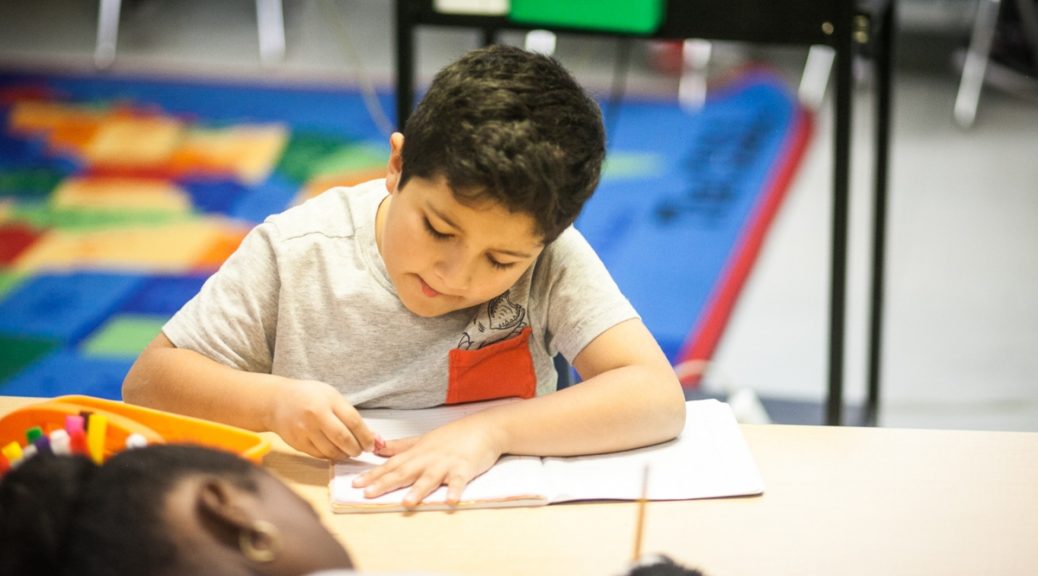Check out our iLEAD AV Hybrid Dream Up Project Video. To watch the video, please click here.
Tag Archives: project based learning
iLEAD Antelope Valley Culture: Project-Based Learning
Editor’s note: This is one in a regular series of articles exploring the pillars and core principles of the iLEAD approach to education.
Spend even just a few moments inquiring about iLEAD Antelope Valley’s approach to education, and one of the first things you’ll hear about is project-based learning, or PBL. It’s at the core of our approach to school and a proven asset to education.
So what is project-based learning? In PBL, learners actively explore real-world challenges to acquire deeper knowledge of the subject at hand. Research shows that learners increasingly retain and enjoy what they’re learning when PBL is done well.
This educational model helps students learn the valuable collaboration, academic, and problem-solving skills our global economy will demand from them. Through the PBL method, learners tackle engaging projects about real-world issues that require critical thought, inquiry, and synthesis, and culminate in regular Presentations of Learning (or POLs) to their peers, facilitators, community members, and parents.
The PBL model requires learners to research, collaborate, and carefully weigh information and evidence in a nuanced problem-solving environment. It teaches learners to accept feedback, create solutions, and present their findings in a high-performance context — preparing them for the rigors of the 21st-century economy and the challenges of a global world.
PBL provides the following benefits:
- PBL makes school more engaging: In PBL, students are active, not passive. Projects engage their hearts and minds and provide real-world relevance for learning.
- PBL improves learning: At the completion of a project, learners understand content more deeply, remember what they learn, and retain it longer than is often the case with traditional instruction. Because of this, students who gain content knowledge with PBL are better able to apply to new situations what they know and can do.
- PBL builds skills for college, career, and life: Learners are preparing for life in a world where success requires more than basic knowledge and skills. In a project, students learn how to take initiative and responsibility, build confidence, solve problems, work in teams, communicate ideas, and manage themselves more effectively.
- PBL helps address standards: Common Core and other current education standards emphasize real-world application of knowledge and skills, as well as the development of success skills like critical thinking/problem-solving, collaboration, communication in a variety of media, and speaking and presentation skills. PBL helps learners effectively meet these goals.
- PBL embraces technology: Kids enjoy using a variety of tech tools that are a perfect fit for PBL. With technology, facilitators and learners not only find resources and information they need; they also collaborate more effectively and connect with experts, partners, and audiences.
- PBL makes teaching more enjoyable and rewarding: Projects allow facilitators to work closely with active, engaged learners doing high-quality, meaningful work. In many cases, facilitators rediscover the joy of learning alongside kids.
- PBL connects kids and schools with communities and the real world: Through PBL, learners have opportunities to solve real problems and address actual issues, and as such they learn more about interacting with adults and organizations, are exposed to workplaces, and can identify and develop career interests.
In short, project-based learning is at the core of the iLEAD Antelope Valley model because we believe it is at the heart of how kids learn best. Time and again, we’ve seen how PBL helps learners develop academic skills, build leadership skills and character, and lay the foundation for promising careers.
iLEAD AV Debuts Schoolwide Art Gallery, Arts Integration
As many schools do, iLEAD AV hosts an annual Winter Production. These are an opportunity for learners, families, and community members to come together and focus on the performing arts. This year, however, Family Engagement Coordinator Holly Vasconez saw an opportunity. Parents, guardians, and families were not only treated to a fantastic performing arts program, but a full-scale art gallery featuring visual arts pieces from learners in grades K- 8.
Vasconez said she got inspired several weeks before the winter program. She decided to take her own love for the visual arts and share them through classroom instruction with each of the grade levels.
She went into classes starting three weeks for the final show in order to introduce each grade level to a different artist, as well as art medium. For example, 3rd grade learned about Vincent Van Gogh and Starry Night, 6th grade learned about Henri Mattis and The Cut-Outs, and 8th grade learned about Claude Monet and his Landscapes. (See complete list Here)
The entire concept was driven by Vasconez and the raw enthusiasm she shares for learners and art.
“I just thought it was a great time to integrate visual arts school wide,” Vasconez said. “I really wanted to feature even more talent and diversity at our annual winter program.”
Although she said she has no formal training in art, Vasconez has worked previously as an arts teacher at another school site and has also traveled through Europe studying art and art history. As she embarked on this newest art adventure, Vasconez said she relied on technology to help her.
“I relied on resources such as YouTube and Pinterest,” she said. “I was learning right alongside the learners, while often staying up until two or three in the morning watching videos and researching online.”
She said she was not only excited about the final art gallery and show, but also about the process the learners experienced. She said from day one she reminded the learners that their art would be displayed publicly and challenged them to do their best.
“I was thrilled with their work throughout the process and in the end,” Vasconez said. “Many of the learners had not enjoyed this much art integration before.”
She was committed to displaying every learner’s art. She made sure each piece was framed and properly identified in order to highlight the art as much as possible.
“We used lights and music to enhance the ambiance,” she said. “We worked to create an interactive art experience for the community.”
Vasconez and the iLEAD AV staff were thrilled with the success of this first all school art gallery, as well as the feedback they received from families and learners alike.
One parent said that he loved how the learners connected to the masters of the various art genres and how they interpreted the art in their own unique ways.
“The learners created some amazing artwork by some iconic artists of our time,” said Josh M.
Another parent said she and her entire family thoroughly loved the entire experience.
“I liked the way it was set up as it reminded me of a museum-art gallery,” said parent Jessica V. “We really enjoyed seeing our own learners’ artwork and the artwork of all their classmates.”
Another parent said she was truly overwhelmed by all of the creativity.
“The Winter Art Gallery was amazing. All of the learners did an incredible job,” said Ivonne V. “We look forward to more future art events like this.”
The iLEAD AV learners were equally impressed with the event and the work of their peers.
“I loved doing the artwork and can’t wait to do more,” said 3rd grader Lia B. “I felt like a real artist and was so excited to see the finished product!”
Other learners commented on their own growth and experience as visual arts.
“When Ms. Holly showed us the painting of Starry Night, I didn’t think I could do it,” said 3rd grader Sheila P. “But once I finished, I really loved the picture and had a great time.”
“I didn’t think I was that great at art, but now I know that I can make some really great art work,” said 4th grader Trinity G. “I am very excited to do more for the next art gallery.”
The staff also took notice. Front office assistant Kelly Uhl said she and her colleagues were overjoyed with all of the learners’ creativity.
“There were so many vibrant colors and creations,” said Uhl. “It was very obvious that every learner put a lot into every masterpiece.”
Registrar Minerva Alonso concurred with Uhl’s assessment of the event.
“I felt extremely honored to be able to witness all of the beautiful work from our learners,” said Alonso. “Kudos to our learners and Ms. Holly for their amazing work.”
Vasconez and the entire iLEAD AV staff are also interested in future art galleries and visual arts integration. This could include an art gallery each semester, Friday or Saturday workshops, as well as infinite opportunities to work with facilitators to integrate art into daily classroom instruction and projects.
“Art is one of the best ways to connect with everyone – learners, parents, families. It’s so personal,” said Vasconez. “We now have learners coming up to me and asking to do more art and have another art show. And that was my goal.”
5 Ways PBL Facilitates Lifelong Learning
We are hearing more and more each day about the changing world of work and what type of skills will define the success of today’s students and future professionals. Outside of education, it’s often called upskilling. In education, we often refer to lifelong learning. Either way, experts agree that an individual’s ability to learn, continuously and adaptively, may define one’s success more than any other employability skills in this ever-changing, tech-infused and globalized economy.
Educators have always professed the priority of creating lifelong learners. But what does this really look like and how can we create learning environments that truly foster this? Project-based learning is poised well to inherently teach learners to become persistent and growth-oriented lifelong learners, among many other advantages.
How does PBL do this? Well, it’s at the core of how PBL functions. Here are a few of those ways:
Real-World Learning
First and foremost, PBL focuses on learners addressing real-world challenges, issues or problems. This immediately creates both relevance and authenticity. The relevancy of working on work that matters demonstrates to students that their school work is related to what others in the real world do and how it applies to their futures, skill development and agency. We talk about problem solving as a foundational skill and it is. However, the problems need to be real. We don’t have to solve them, but students have to continually try to tackle them. This is what all of us do in our professional lives and how new opportunities, jobs, innovations and more advance each day. PBL’s focus on authenticity (or being real world), as a core design principle, creates this real-world learning environment. A project can be authentic in several ways and often in combination. It can have an authentic context, it can involve the use of real-world processes and tools, it can have a real impact on others, and a project can have personal authenticity when it speaks to learners’ own concerns, interests, cultures, identities and issues in their lives.
Sustained Inquiry
This is a core design principle in high quality PBL. To inquire is to seek information or to investigate; it’s a more active, in-depth process than just looking something up in a book or online. The inquiry process takes time, which means a gold standard project lasts more than a few days. In PBL, inquiry is iterative; when confronted with a challenging problem or question, students ask questions, find resources to help answer them, then ask deeper questions, and the process repeats until a satisfactory solution or answer is developed. Projects can incorporate different information sources, mixing the traditional idea of research, reading a book or searching a website, with more real world, field-based interviews with experts, service providers and users. Learners also might inquire into the needs of the users of a product they’re creating in a project, or the audience for a piece of writing or multimedia.
Public Opportunities
In this pursuit of creating lifelong learners, we need to allow learners to experience the true power of learning and the real impact of their work. This is where producing public work, seen by multiple audiences or even users, comes into play.
When people see or even use our work, it creates significance in us. It means one’s work matters. It means learning matters. It means we matter. When audiences see, appreciate, experience, engage in and even possibly benefit from our work we naturally are more engaged, more likely to see the true power of learning. Ultimately, sharing our work publicly provides the opportunity for one to develop their personal brand. It’s the process of sharing one’s high-quality work and getting feedback. This is what we’ll do professionally for the rest of our lives. Lifelong work produces lifelong learning. We buy-in, we have conversations, we consider others’ opinions and ideas; all this while gaining confidence, portfolio, skills, a resume and valuable networking opportunities.
Student Voice & Choice
We hear words like agency, ownership, advocacy, leadership, git and mindset. These are great. And these are really traits of a lifelong learner. But how do we create the environment and means to make these a reality? Having a say in a project creates a sense of ownership in learners; they care more about the project and work harder. If learners are not able to use their judgment when solving a problem and answering a driving question, the project just feels like doing an exercise or following a set of directions. Learners can have input and (some) control over many aspects of a project, from the questions they generate to the resources they will use to find answers to their questions, to the tasks and roles they will take on as team members, to the products they will create. More advanced learners may go even further and select the topic and nature of the project itself; they can write their own driving question and decide how they want to investigate it, demonstrate what they have learned, and how they will share their work. High-quality projects also allow students to assume real roles and responsibilities in the production of their work. Think of things like project coordinator, media coordinator, tech coordinator or dozens of other roles. We don’t create roles for roles’ sake, but rather to move work forward efficiently and allow those involved to specialize a bit (become experts).
The Power of Learning (To Love What You Do)
We’ve all heard the saying that if you “love what you do, you’ll never work a day in your life.” This may be the most powerful aspect of deeper learning like PBL.
Facilitators have always wanted their learners to love learning for learning’s sake. But our traditional system has focused learners more on grades, points or even punitive approaches vs. training them to love learning. PBL, done well, creates the opportunity for learners to focus on the work, the challenge and even the final product. All of these, as well as the opportunity to engage with their peers, their community and the larger world, focus them on the true power of learning. The impact and significance of our work is what drives all of us professionally throughout our lives. When learners produce high-quality and professional projects that are experienced or used by others, addressing real-world issues and products like that of their professional counterparts, they too have that awakening, the internal and external factors that drive us to work, succeed, improve, grow, reach and stretch. We have allowed them to view work and learning differently.
There’s Always More
The beauty of high-quality PBL is that it truly does all the things simultaneously that we think are important in learning. Whether it’s collaboration, metacognition, skill acquisition, social-emotional learning, technology integration, personalized learning or more, PBL can deliver. But with all that being said, nothing may be more important to our learners’ future and sustained success than that of being lifelong learners.
iLEAD Schools Creating Authentic, High Quality Project-Based Learning Environments
View on Getting Smart
iLEAD Schools Creating Authentic, High Quality Project-Based Learning Environments
View on Getting Smart
First-Year iLEAD AV Facilitator Inspires 5th and 6th Graders with Real-World Learning
By Michael Niehoff
Education Content Coordinator, iLEAD Schools
One of the many aspects of sound project-based learning, as well as good instruction in general, is the idea of application. This is about allowing learners to see their learning come to life in real-world forms and situations. First-year iLEAD Antelope Valley facilitator Michael Suzuki has made this his focus for his 5th and 6th grade learners.
Suzuki knows real-world application gives learners purpose for their learning, which motivates them to learn content. Beyond that, though, he believes that real-world learning develops within learners a new way of thinking and a greater understanding of who they are and can become.
“We can become empowered at an early age. Our life and worldview are developed through real-world learning experiences,” Suzuki said. “The way we think about things and how we experience projects will impact and influence our decisions and opportunities along the way.”
This past school year, this idea took hold in a project about carbon footprints. Suzuki challenged learners with the following driving question: “How can we reduce the carbon footprints for individuals, family and community?” Suzuki’s 5th and 6th graders used resources such as The Nature Conservancy to calculate their individual and collective carbon output per year. Learners were challenged to develop and advocate for their own action step.
“They would encourage their peers and others to take action,” Suzuki said. “They would recommend legislation locally and beyond.”
Suzuki loves that his learners are operating at such high levels, researching and taking action.
“They quickly learned that food consumption and production had a big impact on people’s carbon footprints,” Suzuki said. “They learned about meat and its connection to methane. They learned that this issue is complex and has many contributing factors.”
During the spring semester, Suzuki asked his learners to embark on a project where they used geometric shapes to create a blueprint. Using sound project-based learning pedagogy, he created an opportunity for learners to choose something they wanted to design and use digital modeling, research and Google Slides to present their final designs and ideas.
Using math concepts including area and perimeter, learners created blueprints for places in New York, Canada and Italy or more specific locations, such as the Eiffel Tower, Six Flags over Magic Mountain, or even their school.
“This was not just about the math but about the application of the math. They learned to see things differently and established a point of view,” Suzuki said. “They learned how to explain mathematical data and concepts to a lay audience in plain terms.”
For Suzuki, this is the goal. “If they can take complex ideas and make them meaningful to others, then they are truly owning the learning,” he said.
Learners enjoyed having choice, opportunities for creativity and doing individual projects, according to Suzuki. They also did high-quality academic work at the same time.
“They were excited about their individual designs and the research about their choice,” he said. “While the math part was still sometimes challenging, they had a reason to confront the math.”
Suzuki is confident that if he continues to make learning relevant, his learners will remain engaged and successful.
“I will continue to look for projects that use their creative and artistic abilities to better understand math and other subjects,” Suzuki said. “I want to keep finding ways for them to understand and present their findings about any topic or subject but in very unique, creative and personalized ways.”
Resources
See the Blueprint Project Design Guide.
See the Digital Flipbook of the Blueprint Project Presentation of Learning.
Student Work Sample
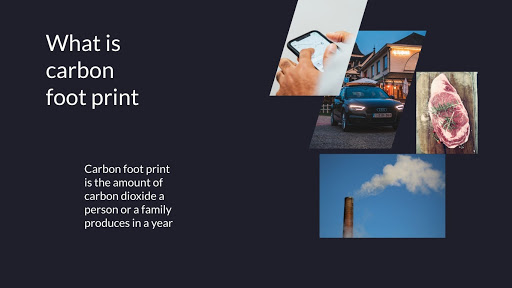
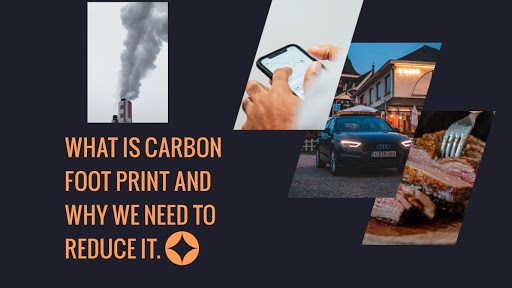
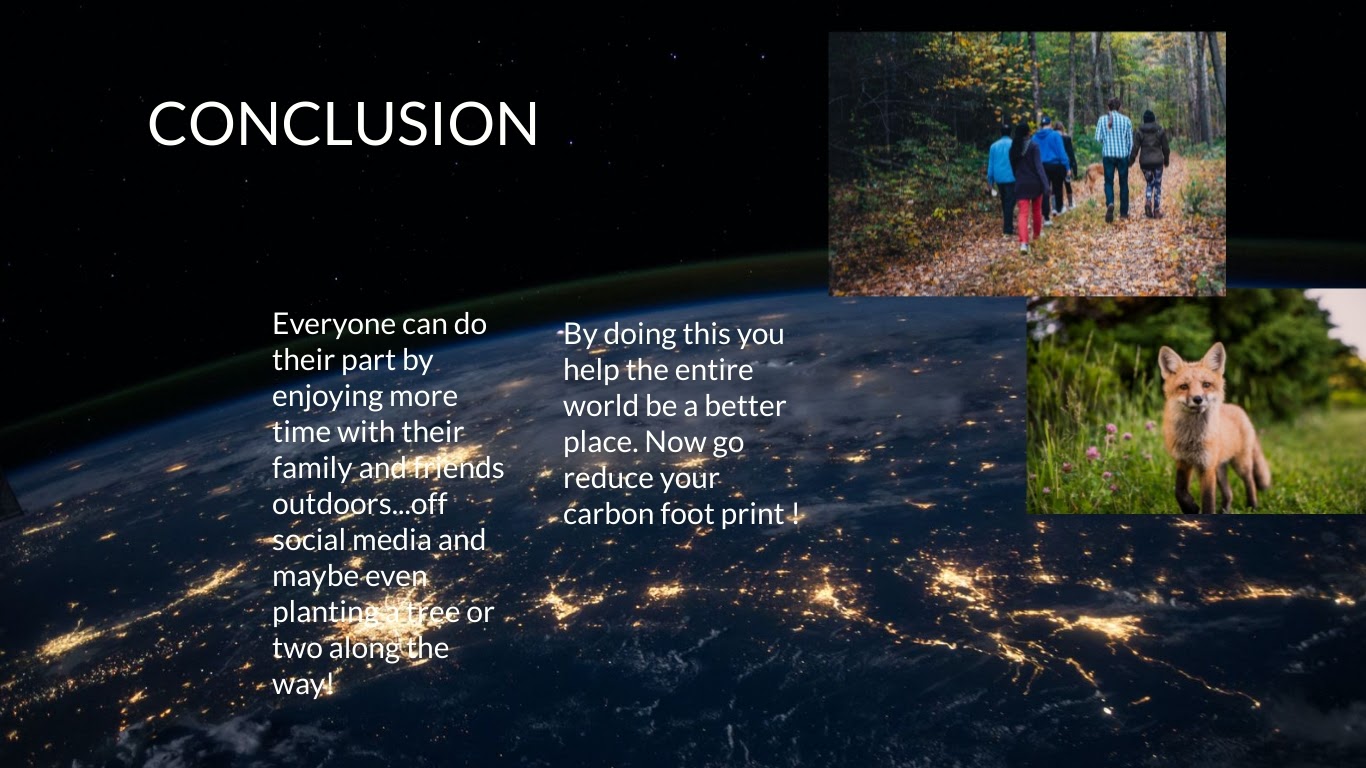
iLEAD AV History Facilitator Priscilla Tucker Inspires Authentic Learning
By Michael Niehoff
Education Content Coordinator, iLEAD Schools
There has often been a disconnect between how educators and learners view the subject of history. Educators know the inherent value of understanding where we have been, while learners often wonder how it relates to where we’re going. Priscilla Tucker, iLEAD Antelope Valley’s 7th and 8th grade social studies facilitator, is focused on bridging that gap.
Having come from Los Angeles Valley Community College as a sociology instructor, Tucker brings a unique perspective. Instead of approaching history through storytelling or as a series of facts and figures, she is challenging all her learners through a sociology lens.
“It’s really an important shift,” Tucker said. “I want my learners to view history as the foundation of how we do everything.”
This approach is centered on essential questions about how we organize ourselves as societies and cultures through government, religion, culture and more.
“We examine and seek to understand how these work and why,” Tucker said. “How do we maintain these structures, what human behavior is at play here and how are these evolving every day?”
As an example, Tucker reminds her learners that their current status as 7th or 8th graders in a free, public school is a product of history.
“This is about getting to the ‘why’ of everything,” Tucker said.
This approach to history is aligned with the inquiry-based instruction of project-based learning (PBL) and also why Tucker said iLEAD is a perfect match for her.
“iLEAD’s PBL approach attracted me to the organization,” Tucker said. “The iLEAD approach to the learners — which is personalized, individualized and connected — is what attracted me.”
Tucker enjoys challenging her learners at high levels and asking the big questions. As an example, after they read the young adult dystopian novel The Giver last year, learners were asked to evaluate their own values and merge those with what a utopian society might look like. They created their own government structures, economies and systems, according to Tucker.
“These efforts and approaches create unique opportunities for deeper discussions and learning,” Tucker said. “This leads to very organic and authentic conversations.”
This year, Tucker aimed to demonstrate that history matters when she asked the learners to compare our current pandemic challenges with the Black Plague. She said learners began realizing that neither these problems nor our responses to them are new.
“One thing we learn from history is that we learn nothing from history,” Tucker said. “Often tragically, we never seem to learn.”
Tucker’s learners also examined the January 6, 2021, insurrection on the nation’s capitol through the lens of the Whiskey Rebellion. Learners considered the national debt and recent COVID stimulus packages alongside stories of the Great Depression. Tucker said these learning opportunities empower learners and bring history to life.
“We have to make it relevant. Everything about them is a consequence of history and what’s come before them,” Tucker said. “It’s a different way of looking at the world, and that’s what we want.”
According to Tucker, the learners’ current project stems from a conversation on Zoom in an advisory session that centered on changing or improving something on campus or at school. Through this process, she said the learners see in real time how change occurs and what avenues we collectively can take to make change. She said the learners will choose something and then consider whom they have to appeal to — school, local government, state government, etc. — in order to enact change.
iLEAD AV Director Dawn Roberson is inspired by Tucker’s powerful approach to both history and learning. “Her focus on the big picture allows her to push her learners to think globally,” Roberson said. “It’s not just about what’s happening in their neighborhood or their city but how the rest of the world is impacted by our actions on social and political levels.”
Tucker and her learners are in the middle of a paradigm shift. She said educators have the opportunity now more than ever to make their subjects — in this case history — relevant by connecting to what’s happening in all of our lives every day.
“We are literally providing our learners social capital to go out into the world and engage,” Tucker said. “We are helping develop their voice and autonomy.”
In the end, Tucker would like all educators — especially her fellow social studies educators — to realize the potential power they have.
“History is unfolding right now,” she said. “That’s the part that’s missing in many of our history classes.”
iLEAD Antelope Valley Culture: Project-Based Learning
Spend even just a few moments inquiring about iLEAD Antelope Valley’s approach to education, and one of the first things you’ll hear about is project-based learning, or PBL. It’s at the core of our approach to school and a proven asset to education.
So what is project-based learning? In PBL, learners actively explore real-world challenges to acquire deeper knowledge of the subject at hand. Research shows that learners increasingly retain and enjoy what they’re learning when PBL is done well.
This educational model helps students learn the valuable collaboration, academic, and problem-solving skills our global economy will demand from them. Through the PBL method, learners tackle engaging projects about real-world issues that require critical thought, inquiry, and synthesis, and culminate in regular Presentations of Learning (or POLs) to their peers, facilitators, community members, and parents.
The PBL model requires learners to research, collaborate, and carefully weigh information and evidence in a nuanced problem-solving environment. It teaches learners to accept feedback, create solutions, and present their findings in a high-performance context — preparing them for the rigors of the 21st-century economy and the challenges of a global world.
PBL provides the following benefits:
- PBL makes school more engaging: In PBL, students are active, not passive. Projects engage their hearts and minds and provide real-world relevance for learning.
- PBL improves learning: At the completion of a project, learners understand content more deeply, remember what they learn, and retain it longer than is often the case with traditional instruction. Because of this, students who gain content knowledge with PBL are better able to apply to new situations what they know and can do.
- PBL builds skills for college, career, and life: Learners are preparing for life in a world where success requires more than basic knowledge and skills. In a project, students learn how to take initiative and responsibility, build confidence, solve problems, work in teams, communicate ideas, and manage themselves more effectively.
- PBL helps address standards: Common Core and other current education standards emphasize real-world application of knowledge and skills, as well as the development of success skills like critical thinking/problem-solving, collaboration, communication in a variety of media, and speaking and presentation skills. PBL helps learners effectively meet these goals.
- PBL embraces technology: Kids enjoy using a variety of tech tools that are a perfect fit for PBL. With technology, facilitators and learners not only find resources and information they need; they also collaborate more effectively and connect with experts, partners, and audiences.
- PBL makes teaching more enjoyable and rewarding: Projects allow facilitators to work closely with active, engaged learners doing high-quality, meaningful work. In many cases, facilitators rediscover the joy of learning alongside kids.
- PBL connects kids and schools with communities and the real world: Through PBL, learners have opportunities to solve real problems and address actual issues, and as such they learn more about interacting with adults and organizations, are exposed to workplaces, and can identify and develop career interests.
In short, project-based learning is at the core of the iLEAD Antelope Valley model because we believe it is at the heart of how kids learn best. Time and again, we’ve seen how PBL helps learners develop academic skills, build leadership skills and character, and lay the foundation for promising careers.
iLEAD Antelope Valley Culture: Project-Based Learning
Spend even just a few moments inquiring about iLEAD Antelope Valley’s approach to education, and one of the first things you’ll hear about is project-based learning, or PBL. It’s at the core of our approach to school and a proven asset to education.
So what is project-based learning? In PBL, learners actively explore real-world challenges to acquire deeper knowledge of the subject at hand. Research shows that learners increasingly retain and enjoy what they’re learning when PBL is done well.
This educational model helps students learn the valuable collaboration, academic, and problem-solving skills our global economy will demand from them. Through the PBL method, learners tackle engaging projects about real-world issues that require critical thought, inquiry, and synthesis, and culminate in regular Presentations of Learning (or POLs) to their peers, facilitators, community members, and parents.
The PBL model requires learners to research, collaborate, and carefully weigh information and evidence in a nuanced problem-solving environment. It teaches learners to accept feedback, create solutions, and present their findings in a high-performance context — preparing them for the rigors of the 21st-century economy and the challenges of a global world.
PBL provides the following benefits:
- PBL makes school more engaging: In PBL, students are active, not passive. Projects engage their hearts and minds and provide real-world relevance for learning.
- PBL improves learning: At the completion of a project, learners understand content more deeply, remember what they learn, and retain it longer than is often the case with traditional instruction. Because of this, students who gain content knowledge with PBL are better able to apply to new situations what they know and can do.
- PBL builds skills for college, career, and life: Learners are preparing for life in a world where success requires more than basic knowledge and skills. In a project, students learn how to take initiative and responsibility, build confidence, solve problems, work in teams, communicate ideas, and manage themselves more effectively.
- PBL helps address standards: Common Core and other current education standards emphasize real-world application of knowledge and skills, as well as the development of success skills like critical thinking/problem-solving, collaboration, communication in a variety of media, and speaking and presentation skills. PBL helps learners effectively meet these goals.
- PBL embraces technology: Kids enjoy using a variety of tech tools that are a perfect fit for PBL. With technology, facilitators and learners not only find resources and information they need; they also collaborate more effectively and connect with experts, partners, and audiences.
- PBL makes teaching more enjoyable and rewarding: Projects allow facilitators to work closely with active, engaged learners doing high-quality, meaningful work. In many cases, facilitators rediscover the joy of learning alongside kids.
- PBL connects kids and schools with communities and the real world: Through PBL, learners have opportunities to solve real problems and address actual issues, and as such they learn more about interacting with adults and organizations, are exposed to workplaces, and can identify and develop career interests.
In short, project-based learning is at the core of the iLEAD Antelope Valley model because we believe it is at the heart of how kids learn best. Time and again, we’ve seen how PBL helps learners develop academic skills, build leadership skills and character, and lay the foundation for promising careers.


